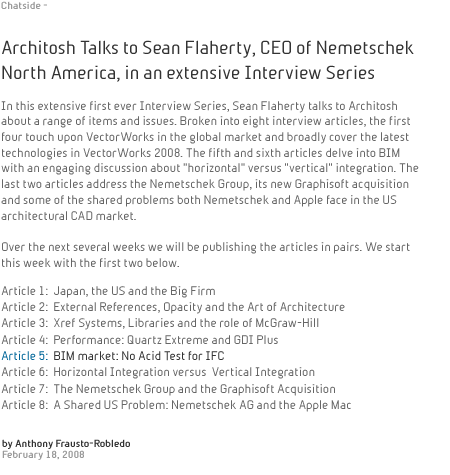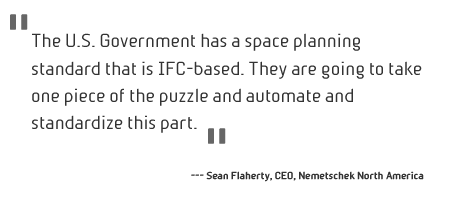|

In
this segment we delve into some aspects of BIM (building
information modeling) that revolve around the interoperability
of data between disparate software applications.
This segment also touches on IFC and ArchiCAD,
if briefly. Sean Flaherty's talk regarding the company's
roles with IFC, government and standards groups
is also promotive to the consideration of VectorWorks
Architect for large architectural practices, as
these practices will no doubt come up against BIM
requests sooner than smaller firms.
Is
the US lagging behind Europe and other parts of the
world in regards to interoperability? This segment
asks the question to a CAD CEO whose product is widely
used in Asia as well as Europe and America.
BIM
market: No Acid Test for IFC
AFR: Are
you at the level of ArchiCAD with IFC with this release?
(SF):
We have both passed IFC 2x3 level 1 certification, and
VectorWorks is seeking level 2 certification. I
believe ArchiCAD has its level 2 certification.
We
don't have the same experience as them. I don't want
to take anything away from them because I know how long
they have been working on this [IFC]. Everyone has to
pass at the same standard to get certified.
What
is lacking with IFC? What are some of the problems with
it?
(SF):
I am always cautioned about the use of data that doesn't
have a clear owner of that resource. That's one
of the reasons why formats like DWG and PDF are so popular,
because there is at least an acid test for them. If it
doesn't look right in Reader, or it doesn't look right
in AutoCAD, then it is not right. It is much more black
and white.
IFC
is a little more like STEP and IGES, which by the way
were much more quickly adopted by the U.S. Government.
This is because it is controlled by a standards body
trying to provide exchange of complex assemblies in a
better way than 2D drawings or pieces of paper. The
economies it introduced into the aerospace industry were
significant, so everybody worked together to produce
an exchange format that worked much better than what
they had. In the end, however, it still isn't
one single cure-all for exchange and there remain many
"flavors" of
IGES and STEP.
Where
does Nemetschek North America then, play a role with
advancing IFC to make it better?
(SF):
People are on the board of directors at different chapters
of IAI all over the world. Nemetschek AG has Rasso Steinmann,
a key player in the European IAI. I am on the board of
directors of the BuildingSmart
Alliance .
So, as a group, we have people scattered all over. They
are part of the community developing this. I think that
right now IFC is happening stronger in Europe than the
U.S. The BuildingSmart Alliance is trying to build an
umbrella organization to tie all these things together.
NIBS (National Institute of Building Sciences) has decided
we need one umbrella
organization in the U.S. for all BIM standards. I think
that is brilliant.

But
every group's view of BIM is so personalized, how do
they ever get together?
(SF):
We talk to the AIA, we talk to CSI and the state organizations;
it is hard to talk to all these people at the same level.
They are all moving in slightly different directions,
and now NIBS has mandated that all U.S. Government groups
pull all of this together. So that when we deliver a
new government facility all these pieces can
talk to each other. I agree this is the right direction.
You
mention that Europe, Scandinavia in particular, was more
on-board with IFC. Is the U.S. Government
trying to play catch-up on some level here?
(SF):
Well... "catch-up" would be a derogatory
term here. The U.S. government has dramatically more
facilities and dramatically more investments in facilities
than all of Scandinavia combined, so by nature they are
going to move more conservatively.
The
Scandinavians, across all technologies, have been much
quicker to adopt open standards. I would not be surprised
that one day the Finnish government, for example, standardizes
on Linux.
Obviously
being in such a cold area, sustainable design and energy
simulation are going to be more important issues than
the average building here in the U.S., so maybe that
has driven the role, also.

Where
do you see the GSA's role in the U.S.?
(SF):
I like what the GSA (General Services Administration)
is doing because they didn't just come out with this.
I think the message got a bit warped when it got to the
average architect -- that the GSA was going to require
BIM and IFC. This is inaccurate and a big blanket statement.
The
U.S. Government has a space planning standard that is
IFC-based. They are going to take one piece of the puzzle
and automate and standardize this part. Then they will
work on the next piece.
So
they have standardized the typical BIM space object via
the IFC format?
(SF):
Yes, this is a great approach. I think this was the very
first time we got something concrete and solvable, and
any CAD package that takes the U.S. Government seriously
would support the IFC-based space object. They have defined
a nice achievable spec.
We
don't need to look a mile ahead and say, "How are
we going to get there?" We need to take one step--
and everyone takes it together. Every six months the
U.S. Government comes out with a new step that we can
take and achieve with a reasonable amount of resources.
What
I see in Singapore and Finland is almost like science
fiction. You see how many extra layers and overhead there
is in the U.S. Government compared to those guys, and
you wonder how this will ever happen. What you see in
the DMA and GSA is that we are still many years away
from the biggest goal of all, which is that buildings
just get transferred electronically and shared with no
errors.
articles:
|
1 | 2 |
3 | 4 | 5 | 6 | 7 | 8 |
Reader
Feedback: Talk to us:
|






![]()
![]()